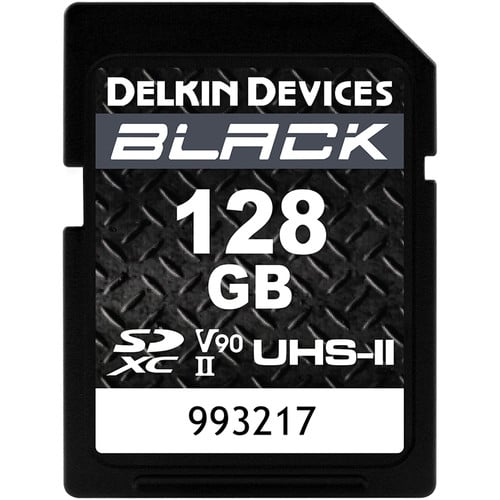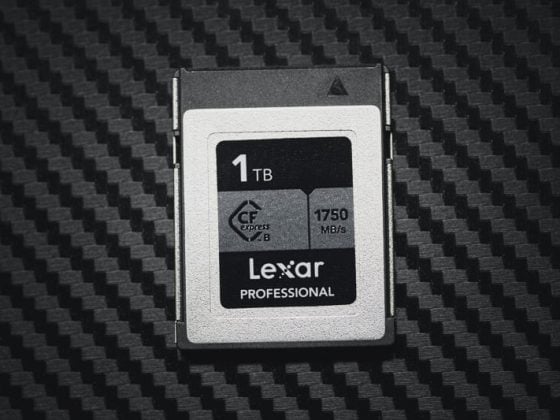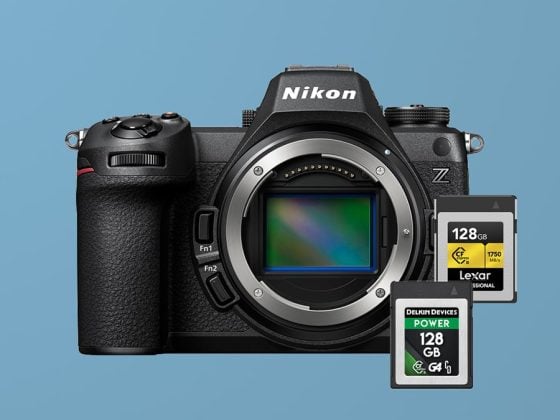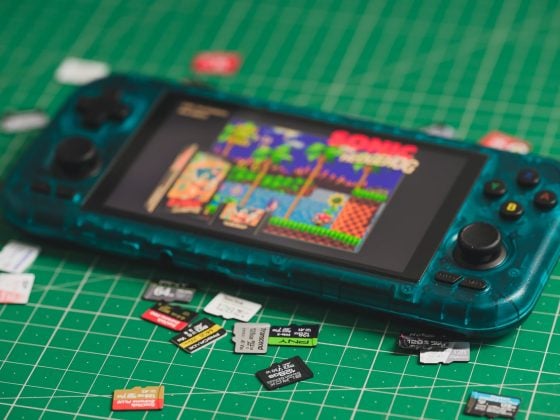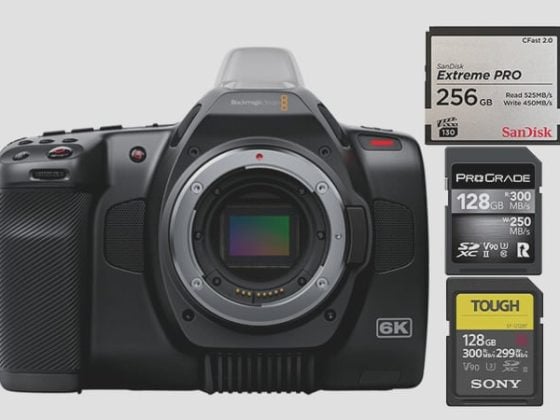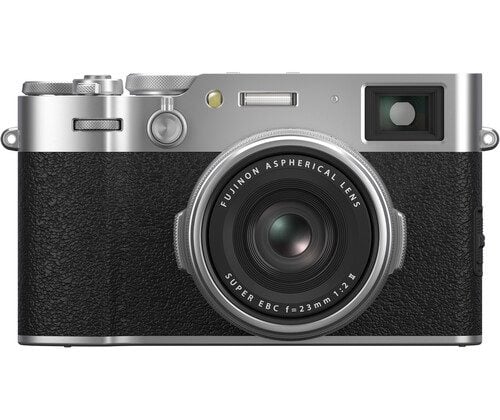The Fujifilm GFX100 II has two memory card slots: one for CFExpress Type-B cards and another for SD UHS-II memory cards.
Fujifilm GFX100 II – Amazon / B&H
Fujifilm’s decision to include both slots is somewhat peculiar, considering the camera’s high-performance features that specifically benefit from CFExpress cards. CFExpress Type-B cards offer faster speeds and are often more affordable than their SD UHS-II V90 counterparts.
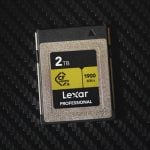
While using this camera, I used the SD card slot as a backup option in case I forgot to bring a CFExpress card (which happens), essentially using it for storage. However, if you plan to record lower-bitrate video (anything below 480Mbps), a UHS-II V60 SD card can still provide excellent value.
After testing 40 different CFexpress Memory Cards in the Fujifilm GFX100 II I’ve put together this chart that features the 7 best – All 40 of the card tested have their in-camera benchmarks listed further down.
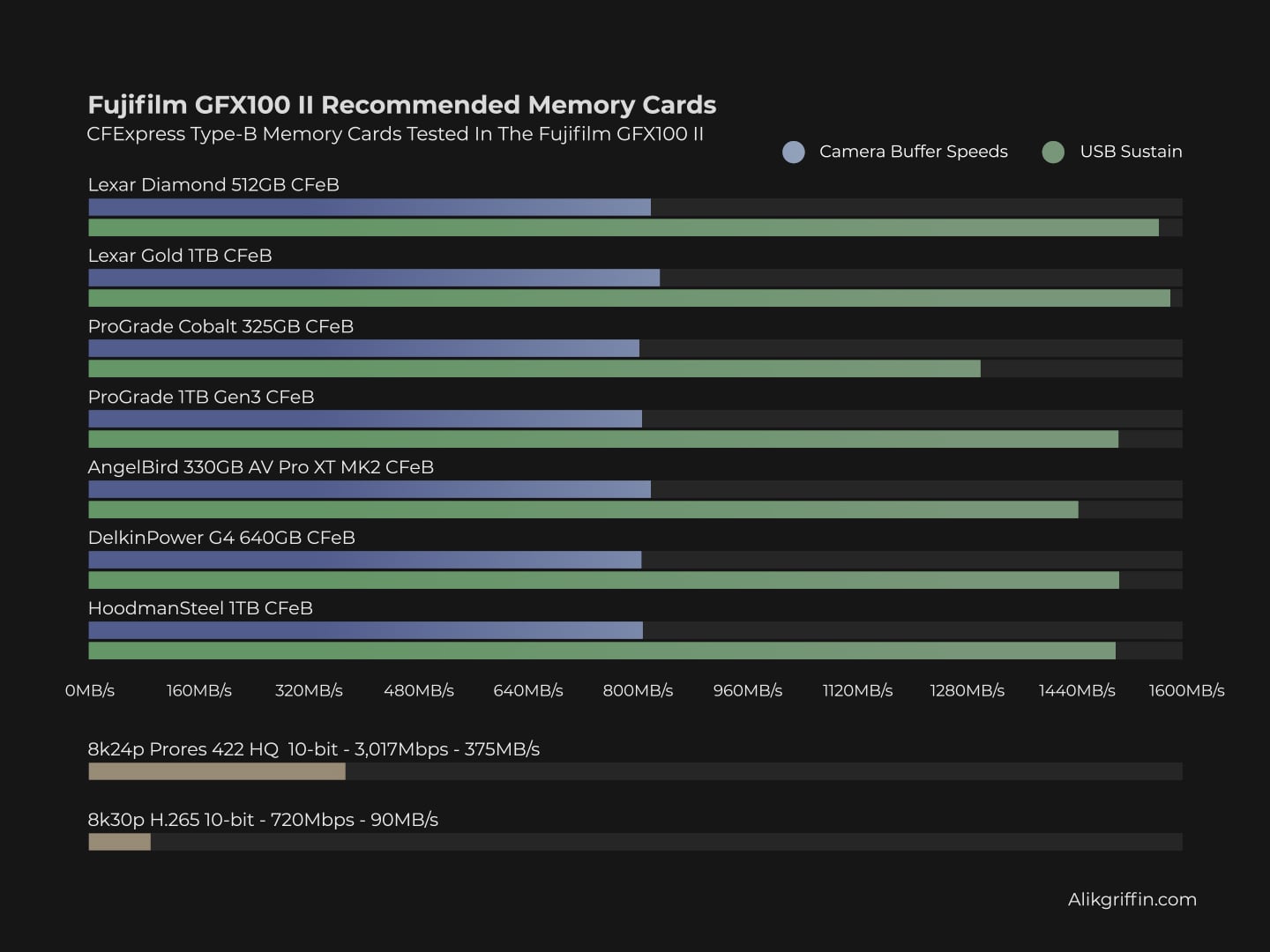
Recommended Memory Cards For The Fujifilm GFX100 II
When buying CFexpress Cards, you don’t want to pick any card randomly. I found some cards to perform very well and others not. If you’re just a casual shooter, you probably don’t need the best CFexpress cards; a midrange card is good enough.
I’ll divide these recommendations into three categories: the Absolute Best Memory cards, The Best Memory Cards For Most People, and the Best Budget Cards.
The Absolute Best Memory Card For The GFX100 II
If you want the best memory card for the GFX 100 II, the crown will go to the Lexar Diamond CFeB cards. I recommend these cards mostly for professional photographers who do a lot of continuous bursting and are willing to spend a little more money for the absolute best.
But there’s a catch, or I should say, here is a pro tip.
The Lexar Diamond ran at 822MB/s, but the 2TB Lexar Gold tested slightly faster at 835MB/s. And the Lexar 1/2TB Gold cards also tested slightly faster at USB-C sustained speeds.
So be sure to consider the price difference of a Diamond card at 512GB vs a 1TB or 2TB Gold card. It probably makes more sense to jump up to a Lexar Gold card at 1TB or 2TB instead of a Diamond card at 512GB. But if you really want a 512GB sized card or smaller, like a 128GB card, stick with the Diamond cards; they will outperform the Gold cards and most cards at those smaller capacities.
The only downside of the Lexar Diamond cards is their limited capacity, making them not a great choice for videographers since the 1TB and 2TB Gold cards offer a better value.
Lexar Diamond Series 256GB CFexpress Type-B
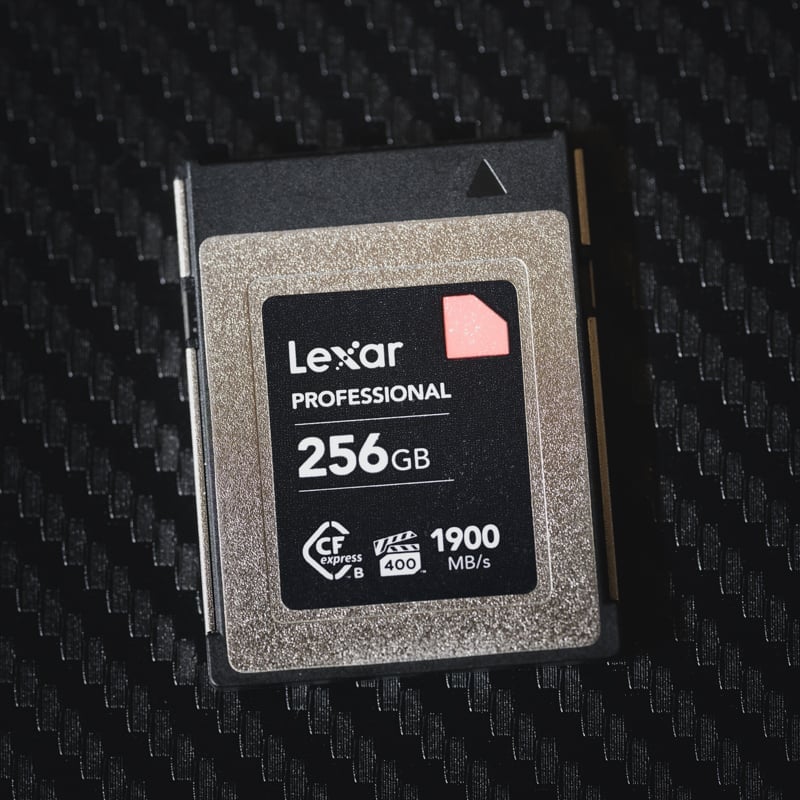
The Lexar Diamond Series CFeB cards have a rated write speed of 1700 MB/s, a rated read speed of 1900 MB/s, and a rated sustain of 1600 MB/s.
Tested Write Speed: 1621 MB/s
Tested Read Speed: 1700 MB/s
Tested Sustain: 1565 MB/s
See Details: Lexar Diamond CFExpress Type-B Review
Warranty: Limited Lifetime Warranty
The Delkin Blacks CFExpress cards usually make this list, but for some reason, they were not performing as fast as the Lexar Diamond cards. However, if you want a Delkin card, be sure to grab the latest Delkin Black G4 cards. Those weren’t available yet when I tested this camera. I usually highly recommend Delkin cards as well. Like Lexar, they are one of the best brands, and their Delkin Black cards have a lifetime warranty with a 48-hour replacement program, which is very cool.
Best Memory Cards For Most People & Videographers
When getting into the high-capacity cards, the Lexar Gold 1TB and 2TB cards perform slightly faster than the Lexar Diamond cards. However, the lower-capacity Gold cards also performed very well.
The Lexar Gold 2TB card came in at an in-camera speed of 835MB/s while the 512GB card had a speed of 801MB/s. Both are very impressive numbers.
Lexar Gold CFexpress Type-B Memory Cards
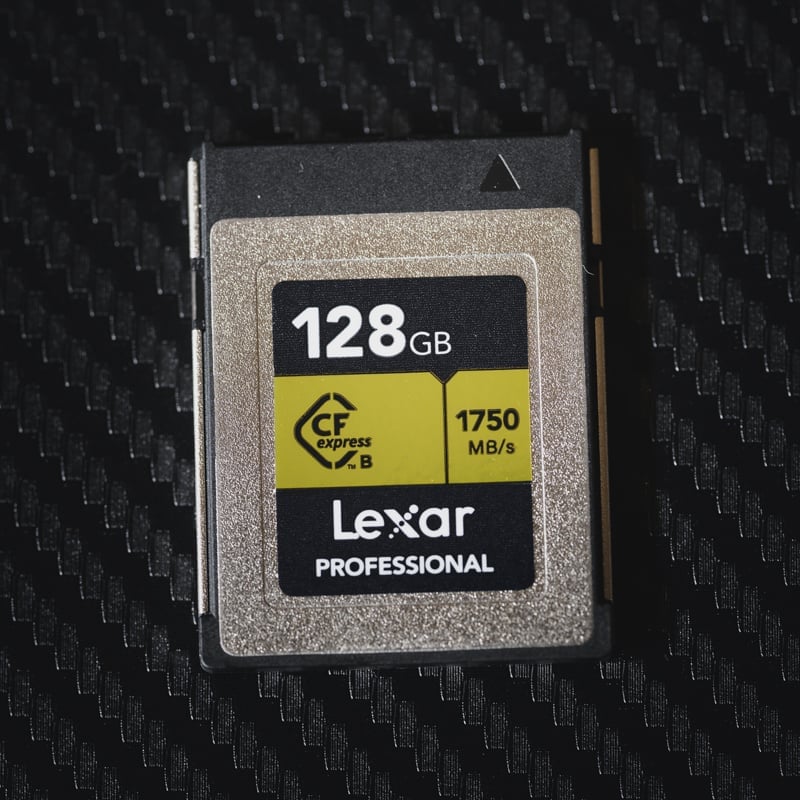
Lexar Gold 128-512GB CFexpress Type B
Tested Write: 1410 MB/s
Tested Read: 1525 MB/s
Tested Sustain: 1382 MB/s
Lexar Gold 1TB-2TB CFexpress Type B
Tested Write Speed: 1642 MB/s
Tested Read Speed: 1695 MB/s
Tested Sustain: 1582 MB/s
Warranty: Limited Lifetime
See Details: Lexar Gold CFExpress Type-B Review
128-256GB
1TB-2TB
The Delkin Power G4 640GB card ran at an in-camera speed of 808MB/s in the Fujifilm GFX100 II making it one of the top performers. Also, its USB-C Sustain speed performs at 1507MB/s which is very good and easily fast enough to handle 8K ProRes.
Delkin Power G4 CFexpress Type-B
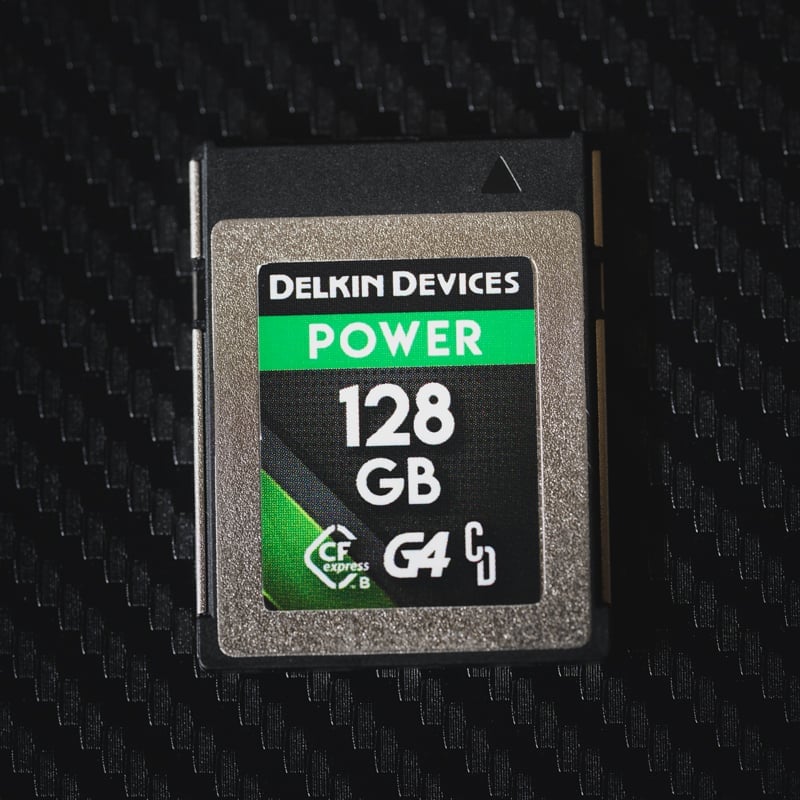
Delkin Power G4 128-512GB CFexpress Type B
Tested Write: 920 MB/s
Tested Read: 1226 MB/s
Tested Sustain: 842 MB/s
Delkin Power G4 650GB-2TB CFexpress Type B
Tested Write Speed: 1588MB/s
Tested Read Speed: 1710MB/s
Tested Sustain: 1507 MB/s
Warranty: Limited Lifetime
See Details: Delkin Power G4 CFExpress Type-B Review
128-256GB
650GB-2TB
The Hoodman Steel 1TB memory card has been a surprising performer in my latest benchmarks. I shot with this card in the GFX100 II and have been using it for a few months in the Nikon Z8 and it pretty much handles everything.
It performed with an in-camera write speed of 810MB/s and has a USB-C sustain speed that I clocked at 1502Mb/s.
Like the Delkin and Lexar Gold cards, the Hoodman cards also feature a tough build and a lifetime warranty.
Hoodman Steel 1TB CFexpress Type-B
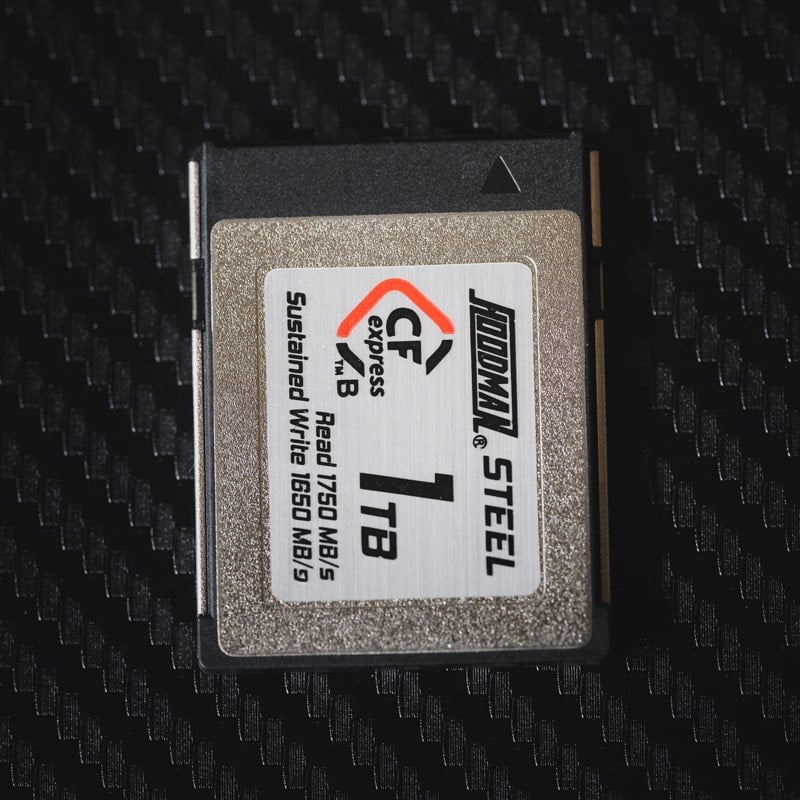
Hoodman Steel 1TB CFexpress Type B cards have a rated write speed of 1650 MB/s and a rated read speed of 1750 MB/s.
Tested Write Speed: 1528 MB/s
Tested Read Speed: 1121 MB/s
Tested Sustain: 1502 MB/s
See Details: Hoodman Steel 1TB CFeB Review
Warranty: Limited Lifetime
1TB
Unfortunately, the Angel Bird 330GB AV XT Pro II card could not make the list because it’s a little too expensive and offers only a 3-year warranty. This makes it not as good a value as the Gold, Delkin G4, and Hoodman cards. The limited warranty also puts it below the Delkin Back and Lexar Diamond cards.
Best Budget Memory Cards
There is only one series of cards I think are worthy of being the Best Budget Cards for the Fujifilm GFX100 II, including the Lexar Silver Series of CFexpress cards.
The card I tested was the Lexar Silver 512GB and it ran at a camera speed of 687MB/s which is still fast enough to handle 8KProres24p with a USB-C sustain speed of 891MB/s. You would probably be cutting it close to run ProRes with the lower-capacity card as they run a little slower.
There is also a Lexar Silver 1TB card that wasn’t available when I was testing this camera, and it’s just been smoking fast with a USB-C sustain speed hitting 1382MB/s.
If you’re shopping for budget memory cards, I highly recommend the Lexar Silver 512GB and 1TB cards.
The only downside to these cards is that they have a limited 10-year warranty and are not advertised with the Tough build. Just pay attention to the different specs and sizes.
Lexar Silver CFexpress Type-B
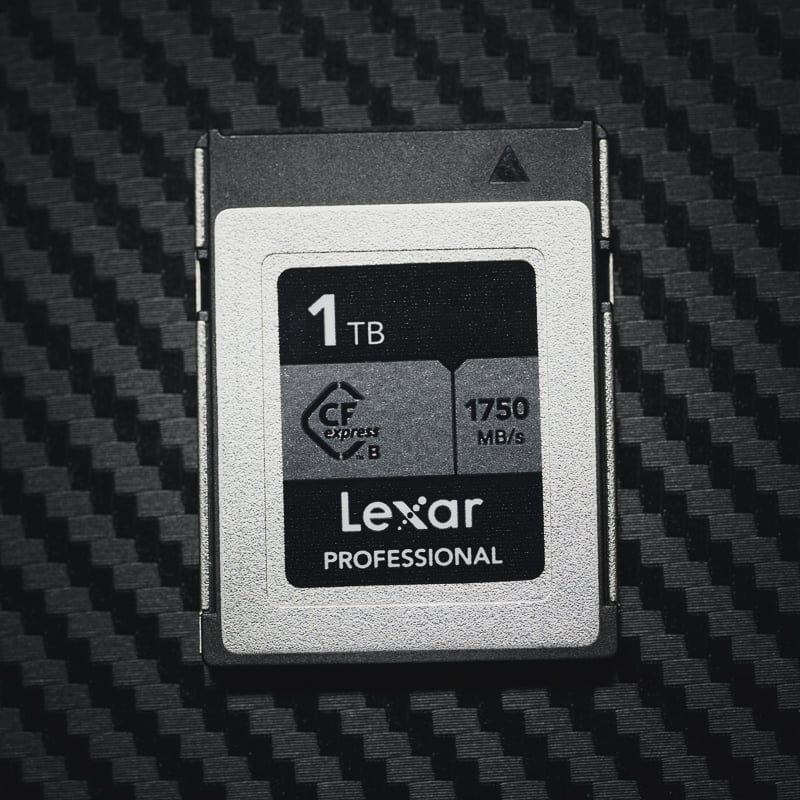
Lexar Silver 128-256GB CFexpress Type B
Tested Write: 749 MB/s
Tested Read: 1719 MB/s
Tested Sustain: 490 MB/s
Lexar Silver 512GB CFexpress Type B
Tested Write Speed: 1141 MB/s
Tested Read Speed: 1624 MB/s
Tested Sustain: 891 MB/s
Lexar Silver 1TB CFexpress Type B
Tested Write: 1661 MB/s
Tested Read: 1732 MB/s
Tested Sustain: 1382 MB/s
Warranty: 10-Year Limited
See Details: Lexar Silver CFexpress Type-B Review
Lexar 128-256GB
Lexar 512GB
Lexar 1TB
Recommended SD UHS-II Memory Cards
I did not benchmark the UHS-II SD memory cards since they should not be the primary cards for most shooters, and honestly, I did not have time. But it wasn’t necessary since cards like the Lexar Silver are not only faster but more affordable than even the best SD V90 cards.
I have, however, tested SD cards in some of Fujifilm’s latest cameras, and I have a few recommendations.
Remember that if you record RAW+RAW Backup in a two-card configuration, the whole camera will slow down to the performance of the UHS-II V90 card. So you’ll want to get the fastest SD memory card you can buy, the V90 UHS-II class. Even if you shoot JPG to backup, JPG files are still pretty big and will slow the system down.
Also, consider that if you’re shooting with film simulations, features like Clarity and Grain will cause a significant CPU bottleneck to the point where memory card performance won’t matter.
Fastest SD V90 UHS-II Memory Cards
My favorite memory cards for Fujifilm cameras are the Sony G Tough cards. I like the build of these cards over all the other Tough cards, like the Delkin Black. They are always top performers and never have firmware compatibility issues with Fujifilm cameras like Sandisk has been having lately.
Sony G Tough V90 UHS-II SD Memory Card
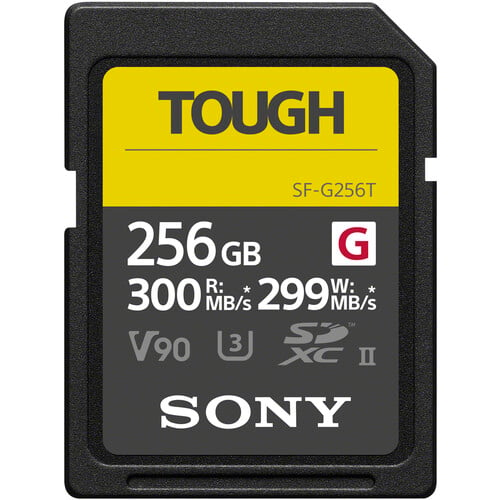
The Sony G Tough v90 UHS-II SD memory card has a tough build and comes in sizes between 32-256GB.
Tested Write Speed: 258 MB/s
Tested Read Speed: 296 MB/s
Rated Sustain: 90 MB/s – 720Mbps
Warranty: Limited 5-Year Manufacturer Warranty
See Details: Sony G Tough V90 UHS-II Review
The Delkin Black UHS-II V90 cards perform flawlessly in every camera even all the latest Fujifilm cameras. These cards can be a little hard to find at different retailers, but I still highly recommend them. They are one of the best cards and always come out on top in all my tests.
A great third option is the Lexar 2000x UHS-II V90 cards. These cards have been performing great in all of Fujifilm’s latest cameras, and they scored well when I was testing memory cards for the Fujifilm X-H2.
Lexar 2000x UHS-II V90 128GB SD Card
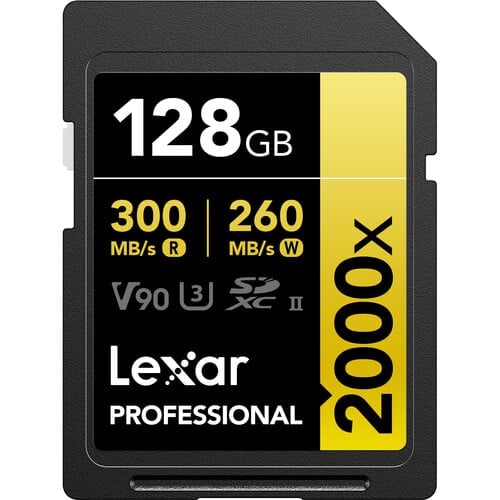
The Lexar Professional 2000x UHS-II SDXC memory card comes in sizes from 32GB to 256GB.
Tested Write Speed: 228MB/s
Tested Read Speed: 256MB/s
Rated Sustain: 90MB/s
Warranty: Limited 10-Year Manufacturer Warranty
See Details: Lexar 2000x UHS-II V90 Review
Best SD V60 UHS-II Memory Card
The Lexar 1800x is the best v60 memory card is the best V60 UHS-II card right now. In the Fujifilm X-H2s, it scored at 164MB/s whereas the second-place card (Sony M Tough V60) scored at 131MB/s. But the Sony M Tough V60 would be my second choice. Sandisk also has some nice new v60 cards that are very fast.
Lexar 1800x UHS-II V60 128GB SD Card
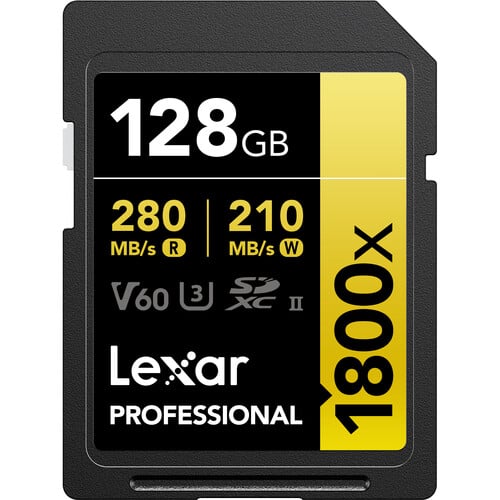
The Lexar 1800x UHS-II SDXC memory card comes in sizes from 32GB to 256GB.
Tested Write Speed: 188MB/s
Tested Read Speed: 255MB/s
Rated Sustain: 60MB/s
Fujifilm GFX100 II Memory Card Buffer Test
To test memory cards in the GFX 100 II, I shot with the electronic shutter in a continuous burst at the fastest speed possible. The E-Shutter can only shoot at 5.3fps, compared to the Mechanical shutter, which shoots at 8fps. I was borrowing this camera and didn’t want to wear out the shutter, so I got these speeds from 5.3fps bursts.
To get the in-camera buffer speeds, I calculated the time it took to clear the buffer and compared that with the amount of data written.
Here, you can see some other great cards hitting some good numbers. If the price is right, OWC, Prograde, and Angelbird cards have been performing well and are pretty solid options.
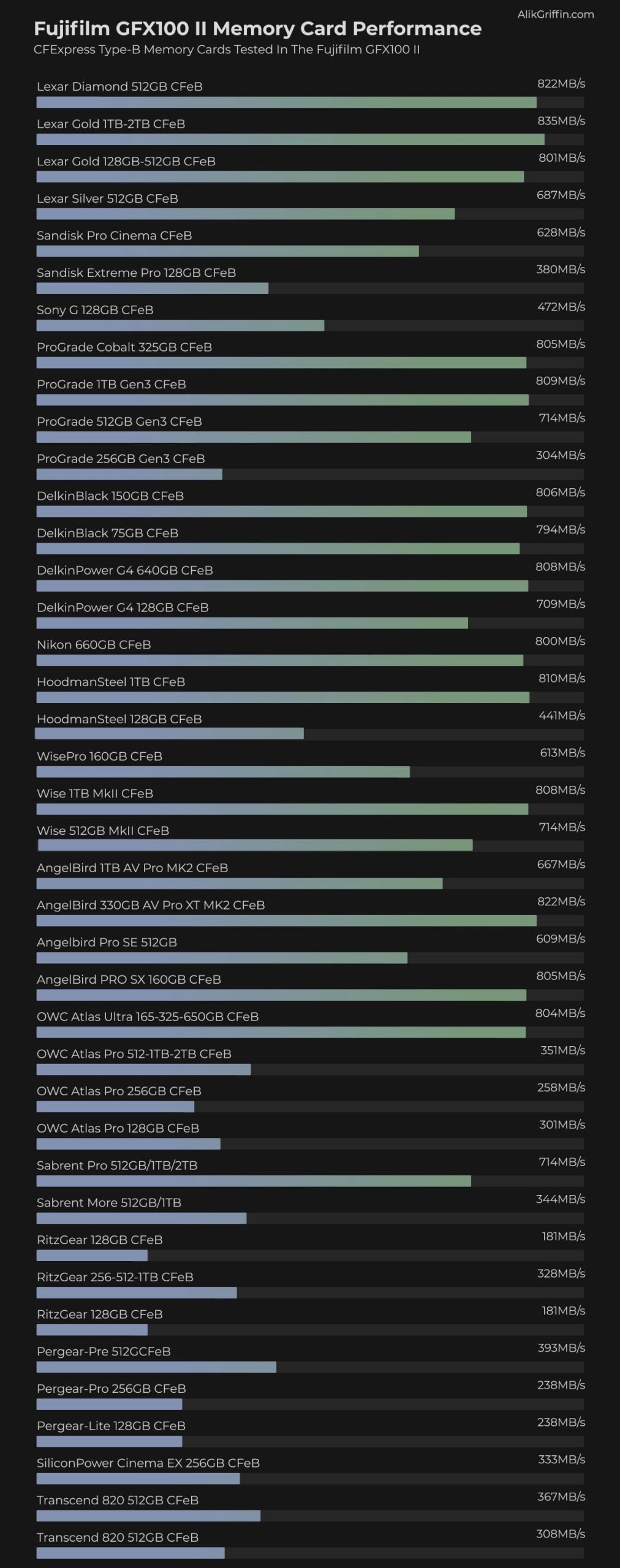
Shoot Video On The GFX 100 II – What Memory Cards?
The Fujifilm GFX100 II has some very impressive video specs. It can shoot 8k ProResHQ at 24fps at a data rate of 375MB/s, or you can shoot H.265 at a data rate of 90MB/s.
Any CFexpress cards I recommended can easily hit these speeds, but you will need CFExpress cards for ProRes 422 HQ recording.
For shooting H.265, the bitrate caps out at 720Mbps or 90MB/s, which means you’ll have to use V90 memory cards or CFExpress cards to shoot in these modes.
| **This website contains affiliate links. We will earn a small commission on purchases made through these links. Some of the links used in these articles will direct you to Amazon. As an Amazon Associate, I earn from qualifying purchases. |

